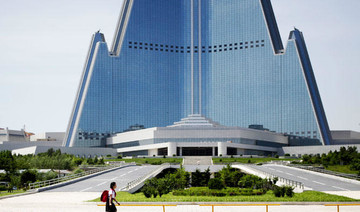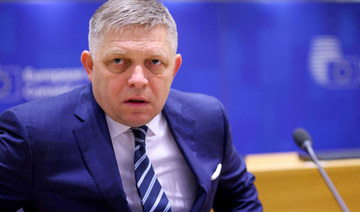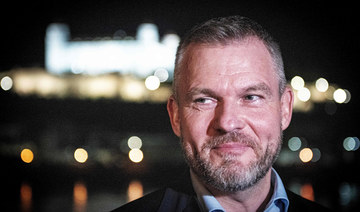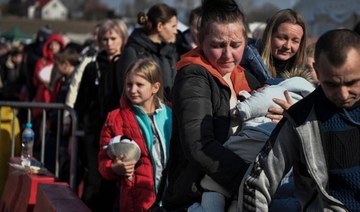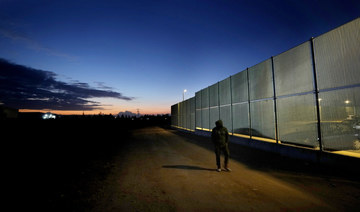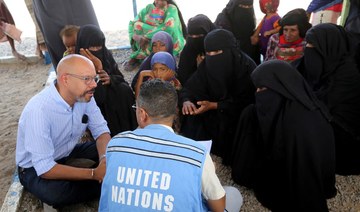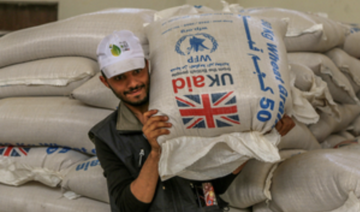WASHINGTON: When North Korea handed over 55 boxes of bones that it said are remains of American war dead, it provided a single military dog tag but no other information that could help US forensics experts determine their individual identities, a US defense official said Tuesday.
The official, who discussed previously undisclosed aspects of the remains issue on condition of anonymity, said it probably will take months if not years to fully determine individual identities from the remains, which have not yet been confirmed by US specialists to be those of American servicemen.
The official did not know details about the single dog tag, including the name on it, or whether it was even that of an American military member. During the Korean War, combat troops of 16 other United Nations member countries fought alongside US service members on behalf of South Korea. Some of them, including Australia, Belgium, France and the Philippines, have yet to recover some of their war dead from North Korea.
The 55 boxes were handed over at Wonsan, North Korea last Friday and flown aboard a US military transport plane to Osan air base in South Korea, where US officials catalogued the contents. After a repatriation ceremony at Osan on Wednesday, the remains will be flown to Hawaii where they will begin undergoing in-depth forensic analysis, in some cases using mitochondrial DNA profiles, at a Defense Department laboratory to attempt to establish individual identifications.
Defense Secretary Jim Mattis said last week that the return of the 55 boxes was a positive step but not a guarantee that the bones are American.
“We don’t know who’s in those boxes,” he said. He noted that some could turn out to be those of missing from other nations that fought in the Korean War. “They could go to Australia,” he said. “They have missing, France has missing, Americans have. There’s a whole lot of us. So, this is an international effort to bring closure for those families.”
Vice President Mike Pence, the son of a Korean War combat veteran, is scheduled to fly to Hawaii for a ceremony, which the military calls an “honorable carry ceremony,” marking the arrival of the remains on American soil at Joint Base Pearl Harbor-Hickam on Wednesday. This will mark a breakthrough in a long-stalled US effort to obtain war remains from North Korea, but officials say it is unlikely to produce quick satisfaction for any of the families of the nearly 7,700 US servicemen who are still listed as missing and unaccounted for from the 1950-53 Korean War.
North Korea provided the 55 boxes in a delayed fulfillment of a commitment its leader, Kim Jong Un, made to President Donald Trump at their Singapore summit on June 12. Although the point of the summit was for Trump to press Kim on giving up his nuclear weapons, their joint statement after the meeting included a single line on an agreement to recover “POW/MIA remains, including the immediate repatriation of those already identified.”
North Korea had told US officials more than once in recent years that it had about 200 sets of US war remains, although none was “already identified.” It remains unclear whether the boxes provided on July 27 include all of the bones North Korea has accumulated over the years. In the past, the North has provided bones that in some cases were not human or that were additional bones of US servicemen already identified from previously recovered remains.
The Pentagon estimates that of the approximately 7,700 US MIAs from the Korean War, about 5,300 are unaccounted for on North Korean soil. Many were buried in shallow graves near where they fell on the battlefield; some others died in North Korean or Chinese-run prisoner of war camps.
Efforts to recover remains in North Korea have been fraught with political and other obstacles since the war ended on July 27, 1953. Between 1990 and 1994, North Korea unilaterally handed over 208 caskets to the US, which turned out to contain remains of far more than 208 individuals, although forensics specialists thus far have established 181 identities. In addition, a series of US-North Korean recovery efforts, termed “joint field activities,” between 1996 and 2005 yielded 229 caskets of remains, of which 153 have been identified, according to the Pentagon.
The Trump administration, as part of the Singapore agreement, is pursuing discussions with North Korea on resuming those “field activities,” for which past administrations have paid millions of dollars in donated vehicles, equipment, food and cash at the request of the North Koreans. The US official who discussed aspects of the return of the 55 boxes on condition of anonymity said the US is considering the possibility of including South Korea in future searches for remains in North Korea. It’s not clear whether negotiations for such an arrangement are under way.
Richard Downes, whose father, Air Force Lt. Hal Downes, is among the Korean War missing, says this turnover of remains, having drawn worldwide attention, has the potential to put the US back on track to finding and eventually identifying many more.
Downes, 70, was 3½ when his father’s B-26 Invader went down on Jan. 13, 1952, northeast of Pyongyang, the North Korean capital. His family was left to wonder about his fate. Downes, now executive director of the Coalition of Families of Korean and Cold War POW/MIAs, which advocates for remains recovery, said he hopes the boxes that arrive in Hawaii on Wednesday prove to be a vanguard that leads to a fuller accounting for families.
“These 55 can set the stage for more to come,” Downes said.
North Korea provided just 1 dog tag with 55 sets of war remains
North Korea provided just 1 dog tag with 55 sets of war remains

- North Korea had told US officials more than once in recent years that it had about 200 sets of US war remains, although none was “already identified”
- The 55 boxes were handed over at Wonsan, North Korea last Friday and flown aboard a US military transport plane to Osan air base in South Korea
ICC ‘excited’ as cricket’s newest stadium launched in New York

- Thirty-four thousand-capacity stadium will host hotly-anticipated India-Pakistan clash on June 9
- Stadium features infrastructure from Las Vegas Formula 1 circuit, drop-in pitches prepared in Florida
NEW DELHI: The newly-built Nassau County International Cricket Stadium, near New York, was launched on Wednesday with the sport’s world body “excited” to conquer new territories through the T20 World Cup in June.
The 34,000-capacity stadium, with infrastructure from the Las Vegas Formula 1 circuit and drop-in pitches prepared in Florida, will host the hotly-anticipated India-Pakistan clash on June 9, among its eight scheduled World Cup games.
The showpiece 20-over event will be co-hosted by the West Indies and the United States starting June 1 with New York, Florida and Dallas as venues.
The International Cricket Council (ICC) remains happy with the focus on the India-Pakistan clash and the Nassau project as part of bringing the game to the US.
“Yeah, absolutely! We can run that game anywhere and the interest in the fixture would be immense,” Chris Tetley, the ICC’s head of events, told reporters in a media roundtable.
“The news stories that we have seen and the media coverage in the US itself as well as among the cricket media around the world. I have not seen that before around an ICC event.”
Tetley added: “We are really excited to bring the T20 World Cup cricket to the US and the opportunity that it presents to the sport and from what I can see there is an audience really waiting for us to come.”
T20 Cricket will also feature as one of five new sports at the Los Angeles Olympics in 2028.
Making a cricket stadium in Nassau remained a huge challenge for the ICC, who got in Adelaide Oval curator Damian Hough for the job.
Hough created the first drop-in pitch in Adelaide in 2013 and the latest strips at the Nassau County ground promise good cricket and balance between bat and ball.
“People shouldn’t be concerned about drop-in pitches,” said Hough.
“They are proven around the world, definitely in Australia. Some of the best cricket is played on drop-in pitches and are really successful.”
Slovak PM’s ‘life in danger’ and in operating theater: interior minister

- Matus Sutaj Estok: We received information from the operating doctors that the prime minister is in a critical condition and his life is in danger and he is still in the operating theater
- European Commission President Ursula von der Leyen condemned what she described as a ‘vile attack’
BANSKA BYSTRICA, Slovakia: Slovak Prime Minister Robert Fico’s life “is in danger” and he is still in the operating theater after being shot multiple times, the country’s interior minister said on Wednesday.
“We received information from the operating doctors that the prime minister is in a critical condition and his life is in danger and he is still in the operating theater,” Matus Sutaj Estok told reporters at the hospital where Fico is being treated.
Reports on TA3, a Slovakian TV station, said that Fico, 59, was hit in the stomach after four shots were fired outside the House of Culture in the town of Handlova, some 150 kilometers northeast of the capital, where the leader was meeting with supporters. A suspect has been detained, it said.
Police sealed off the scene, and Fico was taken to a hospital in Banska Bystrica.
The shooting in Slovakia comes three weeks ahead of crucial European Union Parliament elections, in which populist and hard-right parties in the 27-nation bloc appear poised to make gains.
Deputy speaker of parliament Lubos Blaha confirmed the incident during a session of Parliament and adjourned it until further notice, the Slovak TASR news agency said.
Slovakia’s major opposition parties, Progressive Slovakia and Freedom and Solidarity, canceled a planned protest against a controversial government plan to overhaul public broadcasting that they say would give the government full control of public radio and television.
“We absolutely and strongly condemn violence and today’s shooting of Premier Robert Fico” said Progressive Slovakia leader Michal Simecka. “At the same time we call on all politicians to refrain from any expressions and steps which could contribute to further increasing the tension.”
President Zuzana Caputova condemned “a brutal and ruthless” attack on the premier.
“I’m shocked,” Caputova said. “I wish Robert Fico a lot of strength in this critical moment and a quick recovery from this attack.”
Fico, a third-time premier, and his leftist Smer, or Direction, party, won Slovakia’s Sept. 30 parliamentary elections, staging a political comeback after campaigning on a pro-Russian and anti-American message.
Critics worried Slovakia under Fico would abandon the country’s pro-Western course and follow the direction of Hungary under populist Prime Minister Viktor Orbán.
Thousands have repeatedly rallied in the capital and across Slovakia to protest Fico’s policies.
Condemnations of political violence came from leaders across Europe.
European Commission President Ursula von der Leyen condemned what she described as a “vile attack.”
“Such acts of violence have no place in our society and undermine democracy, our most precious common good,” von der Leyen said in a post on X.
Leaders in Latvia and Estonia also quickly condemned political violence.
Polish Prime Minister Donald Tusk wrote on the social media network X: “Shocking news from Slovakia. Robert, my thoughts are with you in this very difficult moment.”
EU agrees on a new migration pact, as mainstream parties hope it will deprive the far right of votes
EU agrees on a new migration pact, as mainstream parties hope it will deprive the far right of votes

- EU government ministers approved 10 legislative parts of The New Pact on Migration and Asylum
- Mainstream political parties believe the pact resolves the issues that have divided member nations since migrants swept into Europe in 2015, most fleeing war in Syria and Iraq
BRUSSELS: European Union nations endorsed sweeping reforms to the bloc’s failed asylum system on Tuesday as campaigning for Europe-wide elections next month gathers pace, with migration expected to be an important issue.
EU government ministers approved 10 legislative parts of The New Pact on Migration and Asylum. It lays out rules for the 27 member countries to handle people trying to enter without authorization, from how to screen them to establish whether they qualify for protection to deporting them if they’re not allowed to stay.
Hungary and Poland, which have long opposed any obligation for countries to host migrants or pay for their upkeep, voted against the package but were unable to block it.
Mainstream political parties believe the pact resolves the issues that have divided member nations since well over 1 million migrants swept into Europe in 2015, most fleeing war in Syria and Iraq. They hope the system will starve the far right of vote-winning oxygen in the June 6-9 elections.
However, the vast reform package will only enter force in 2026, bringing no immediate fix to an issue that has fueled one of the EU’s biggest political crises, dividing nations over who should take responsibility for migrants when they arrive and whether other countries should be obligated to help.
Critics say the pact will let nations detain migrants at borders and fingerprint children. They say it’s aimed at keeping people out and infringes on their right to claim asylum. Many fear it will result in more unscrupulous deals with poorer countries that people leave or cross to get to Europe.
WHY ARE THE NEW RULES NEEDED?
Europe’s asylum laws have not been updated for about two decades. The system frayed and then fell apart in 2015. It was based on the premise that migrants should be processed, given asylum or deported in the country they first enter. Greece, Italy and Malta were left to shoulder most of the financial burden and deal with public discontent. Since then, the ID-check-free zone known as the Schengen Area has expanded to 27 countries, 23 of them EU members. It means that more than 400 million Europeans and visitors, including refugees, are able to move without showing travel documents.
WHO DO THE RULES APPLY TO?
Some 3.5 million migrants arrived legally in Europe in 2023. Around 1 million others were on EU territory without permission. Of the latter, most were people who entered normally via airports and ports with visas but didn’t go home when they expired. The pact applies to the remaining minority, estimated at around 300,000 migrants last year. They are people caught crossing an external EU border without permission, such as those reaching the shores of Greece, Italy or Spain via the Mediterranean Sea or Atlantic Ocean on boats provided by smugglers.
HOW DOES THE SYSTEM WORK?
The country on whose territory people land will screen them at or near the border. This involves identity and other checks -– including on children as young as 6. The information will be stored on a massive new database, Eurodac. This screening should determine whether a person might pose a health or security risk and their chances of being permitted to stay. Generally, people fleeing conflict, persecution or violence qualify for asylum. Those looking for jobs are likely to be refused entry. Screening is mandatory and should take no longer than seven days. It should lead to one of two things: an application for international protection, like asylum, or deportation to their home country.
WHAT DOES THE ASYLUM PROCEDURE INVOLVE?
People seeking asylum must apply in the EU nation they first enter and stay until the authorities there work out what country should handle their application. It could be that they have family, cultural or other links somewhere else, making it more logical for them to be moved. The border procedure should be done in 12 weeks, including time for one legal appeal if their application is rejected. It could be extended by eight weeks in times of mass movements of people. Procedures could be faster for applicants from countries whose citizens are not often granted asylum. Critics say this undermines asylum law because applicants should be assessed individually, not based on nationality. People would stay in “reception centers” while it happens, with access to health care and education. Those rejected would receive a deportation order.
WHAT DOES DEPORTATION INVOLVE?
To speed things up, a deportation order is supposed to be issued automatically when an asylum request is refused. A new 12-week period is foreseen to complete this process. The authorities may detain people throughout. The EU’s border and coast guard agency would help organize joint deportation flights. Currently, less than one in three people issued with an order to leave are deported. This is often due to a lack of cooperation from the countries these people come from.
HOW HAS THE ISSUE OF RESPONSIBILITIES VS OBLIGATIONS BEEN RESOLVED?
The new rules oblige countries to help an EU partner under migratory pressure. Support is mandatory, but flexible. Nations can relocate asylum applicants to their territory or choose some other form of assistance. This could be financial -– a relocation is evaluated at 20,000 euros ($21,462) per person -– technical or logistical. Members can also assume responsibility for deporting people from the partner country in trouble.
WHAT CHALLENGES LIE AHEAD?
Two issues stand out: Will member countries ever fully enact the plan, and will the EU’s executive branch, the European Commission, enforce the new rules when it has chosen not to apply the ones already in place? The commission is due to present a Common Implementation Plan by June. It charts a path and timeline to get the pact working over the next two years, with targets that the EU and member countries should reach. Things could get off to a rocky start. Hungary, which has vehemently opposed the reforms, takes over the EU’s agenda-setting presidency for six months on July 1.
Calls mount on Polish government to expel Israeli envoy

- Israel dismissed calls for accountability after killing Polish aid worker in Gaza
- Ambassador compares peaceful protests in Poland to Nazi rallies
WARSAW: Polish activists on Wednesday submitted a nationwide petition for the government to immediately expel the Israeli ambassador over war crimes in Gaza.
Protests against Israel’s bombardment of the Palestinian enclave have been a regular occurrence in Poland since the beginning of the onslaught in October.
One of the main groups organizing the rallies and meetings to extend political pressure, and bring Poles closer to Palestinian history and culture, is the initiative Wschod — a movement of young activists dedicated to social justice.
Wschod’s petition to expel the Israeli envoy, Yacov Livne, from Poland, was signed by 7,931 people as of Wednesday.
“I believe that the petition is an important signal to the Polish government from the Polish people,” Zofia Hecht, a member of Wschod, told Arab News as the activists submitted the petition to the Ministry of Foreign Affairs in Warsaw.
“There is a large group of people who really do not agree with what Israel is doing to Palestinians, and that we do not agree to normalize relations with such a terrorist entity that is Israel.”
Poland recognizes Palestinian statehood and has voted in favor of the UN’s recent resolutions to demand an immediate ceasefire in Gaza, and to recognize backing Palestine’s bid for permanent membership status.
A close ally of the US, the Polish government has avoided vocal criticism of Tel Aviv and its war on Gaza, where Israeli forces have over the past seven months killed at least 35,000 people — a large majority women and children — and injured 80,000 more.
UN agencies and experts have repeatedly accused Israel of committing war crimes and crimes against humanity in Gaza. The International Court of Justice in January also found it plausible that Tel Aviv’s actions in the enclave could amount to genocide.
“We think that the previous actions taken by the Polish government to prevent the Israeli genocide in Gaza were not sufficient,” said Emil Al-Khawaldeh, Wschod’s Palestine campaign coordinator.
“We expect the Polish government to at least respond to our petition signed by almost 8,000 people, and to meet our demands to expel the Israeli ambassador.”
The petition was created when Poles began to pay more attention to Gaza after the killing of a Polish national, Damian Sobol, who was one of the seven World Central Kitchen aid workers targeted and killed by Israeli troops in early April.
“In April, when Israel killed a Polish citizen, the Israeli ambassador took to Twitter to publish accusations of antisemitism,” Al-Khawaldeh said, citing Livne’s posts, which included labeling a Polish parliament deputy speaker as an “antisemite” for publicly charging Israel with war crimes.
“Until now, the Israeli ambassador has neither apologized for his own words nor, on behalf of the state of Israel, for murdering a Polish citizen,” he added.
Wschod’s petition to the government says that “there is no place” in Poland for an ambassador of a “state committing genocide” and demands that he be “immediately” expelled.
“It is absurd that in a country historically affected by genocide, hatred and hostility, we allow the holding of office by a person who represents the government of a country committing war crimes against innocent Palestinian civilians,” it reads.
About 6 million Polish citizens, including 3 million Polish Jews, were killed by German forces during the invasion and occupation of Poland in the Second World War. The occupation policies have been recognized in Europe as a genocide.
Eight decades later, as Poles unite and take to the streets to prevent a genocide of another people, Al-Khawaldeh, who is Polish Palestinian, and Hecht, who is Jewish, said that they have faced accusations of antisemitism.
The accusations regularly come from the Israeli ambassador, who, in a radio interview in November, went as far as to compare the Polish peace activists to Nazis.
“We’ve been holding peaceful marches in Warsaw and there’s been no single security incident. But in November, the Israeli ambassador compared the marches to Nazi rallies ... he compared us with the Nazi Germany of the 1930s,” Al-Khawaldeh said.
“Polish Jews are also protesting with us. They are organizing protests in Poland, peaceful protests, they are also having wonderful speeches against Israeli war crimes, against Israeli genocide in Gaza. This accusation is absurd.”
UK announces $175 million humanitarian aid boost for Yemen

- Nearly 200 aid groups called for more humanitarian aid this month to bridge a $2.3-billion shortfall in funds for Yemen
LONDON: The UK will significantly increase aid funding to Yemen aiming to feed more than 850,000 people in the war-torn country, Foreign Secretary David Cameron said on Wednesday.
New aid worth £139 million (around $175 million) to help alleviate the humanitarian crisis in Yemen was announced in a meeting between Cameron and Yemeni Prime Minister Ahmed Awad bin Mubarak in London.
The aid will be delivered through partners such as the World Food Programme and Unicef, a statement read, and hopes to treat 700,000 severely malnourished children.
The move comes a week after the EU announced $125 million for NGOs and UN agencies working in Yemen, where more than half the 34 million population needs aid after nine years of war.
Nearly 200 aid groups called for more humanitarian aid this month to bridge a $2.3-billion shortfall in funds for Yemen.
Houthi rebel attacks on international shipping are also on the agenda in Cameron’s meeting with Bin Mubarak, who is Yemen’s former ambassador to the United States.
Cameron blamed the attacks on Red Sea shipping for aggravating the humanitarian crisis “through blocking aid from reaching those who need it in northern Yemen.”
British and US forces have been carrying out joint strikes since January aimed at curbing the raids.
The attacks, which began in November, were found to affect more than half of British exporters in a British Chambers of Commerce report from February.
Yemen has been gripped by conflict following a 2014 coup by the Iran-backed Houthi rebels, which triggered a Saudi-led military intervention in support of the government the following year.
Hundreds of thousands have died from fighting and other indirect causes such as the lack of food, according to the UN.
While hostilities have remained at a low level since a six-month UN-brokered ceasefire came into force in 2022, threats including food insecurity and cholera remain rampant.


